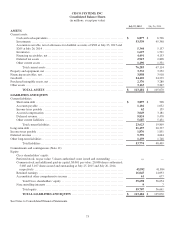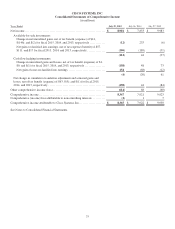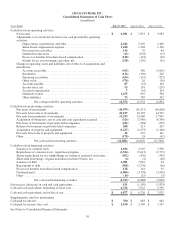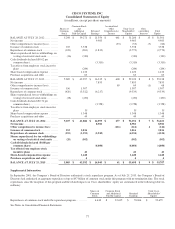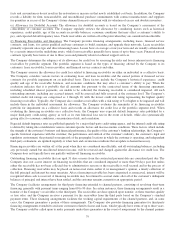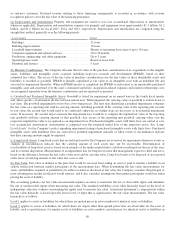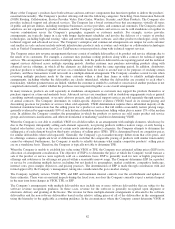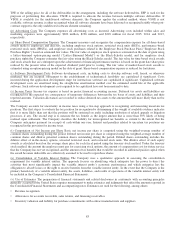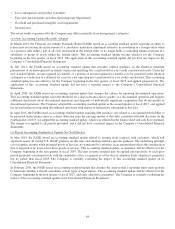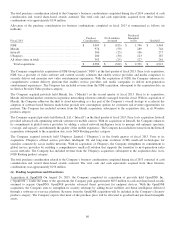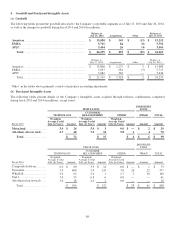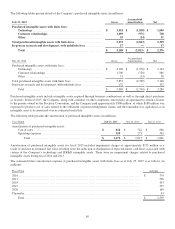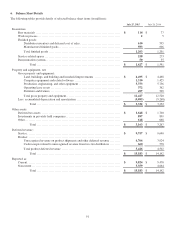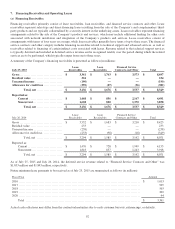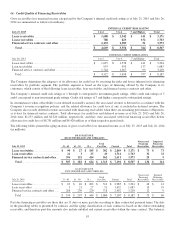Cisco 2015 Annual Report Download - page 91
Download and view the complete annual report
Please find page 91 of the 2015 Cisco annual report below. You can navigate through the pages in the report by either clicking on the pages listed below, or by using the keyword search tool below to find specific information within the annual report.
TPE of the selling price for all of the deliverables in the arrangement, including the software deliverables, ESP is used for the
purposes of performing this allocation. VSOE is required to allocate the revenue between multiple software deliverables. If
VSOE is available for the undelivered software elements, the Company applies the residual method; where VSOE is not
available, software revenue is either recognized when all software elements have been delivered or recognized ratably when post-
contract support is the only undelivered software element remaining.
(p) Advertising Costs The Company expenses all advertising costs as incurred. Advertising costs included within sales and
marketing expenses were approximately $202 million, $196 million, and $218 million for fiscal 2015, 2014, and 2013,
respectively.
(q) Share-Based Compensation Expense The Company measures and recognizes the compensation expense for all share-based
awards made to employees and directors, including employee stock options, restricted stock units (RSUs), performance-based
restricted stock units (PRSUs), and employee stock purchases related to the Employee Stock Purchase Plan (“Employee Stock
Purchase Rights”) based on estimated fair values. The fair value of employee stock options is estimated on the date of grant using
a lattice-binomial option-pricing model (“Lattice-Binomial Model”) or the Black-Scholes model, and for employee stock
purchase rights the Company estimates the fair value using the Black-Scholes model. The fair value for time-based stock awards
and stock awards that are contingent upon the achievement of financial performance metrics is based on the grant date share price
reduced by the present value of the expected dividend yield prior to vesting. The fair value of market-based stock awards is
estimated using an option-pricing model on the date of grant. Share-based compensation expense is reduced for forfeitures.
(r) Software Development Costs Software development costs, including costs to develop software sold, leased, or otherwise
marketed, that are incurred subsequent to the establishment of technological feasibility are capitalized if significant. Costs
incurred during the application development stage for internal-use software are capitalized if significant. Capitalized software
development costs are amortized using the straight-line amortization method over the estimated useful life of the applicable
software. Such software development costs required to be capitalized have not been material to date.
(s) Income Taxes Income tax expense is based on pretax financial accounting income. Deferred tax assets and liabilities are
recognized for the expected tax consequences of temporary differences between the tax bases of assets and liabilities and their
reported amounts. Valuation allowances are recorded to reduce deferred tax assets to the amount that will more likely than not be
realized.
The Company accounts for uncertainty in income taxes using a two-step approach to recognizing and measuring uncertain tax
positions. The first step is to evaluate the tax position for recognition by determining if the weight of available evidence indicates
that it is more likely than not that the position will be sustained on audit, including resolution of related appeals or litigation
processes, if any. The second step is to measure the tax benefit as the largest amount that is more than 50% likely of being
realized upon settlement. The Company classifies the liability for unrecognized tax benefits as current to the extent that the
Company anticipates payment (or receipt) of cash within one year. Interest and penalties related to uncertain tax positions are
recognized in the provision for income taxes.
(t) Computation of Net Income per Share Basic net income per share is computed using the weighted-average number of
common shares outstanding during the period. Diluted net income per share is computed using the weighted-average number of
common shares and dilutive potential common shares outstanding during the period. Diluted shares outstanding includes the
dilutive effect of in-the-money options, unvested restricted stock, and restricted stock units. The dilutive effect of such equity
awards is calculated based on the average share price for each fiscal period using the treasury stock method. Under the treasury
stock method, the amount the employee must pay for exercising stock options, the amount of compensation cost for future service
that the Company has not yet recognized, and the amount of tax benefits that would be recorded in additional paid-in capital when
the award becomes deductible are collectively assumed to be used to repurchase shares.
(u) Consolidation of Variable Interest Entities The Company uses a qualitative approach in assessing the consolidation
requirement for variable interest entities. The approach focuses on identifying which enterprise has the power to direct the
activities that most significantly impact the variable interest entity’s economic performance and which enterprise has the
obligation to absorb losses or the right to receive benefits from the variable interest entity. In the event that the Company is the
primary beneficiary of a variable interest entity, the assets, liabilities, and results of operations of the variable interest entity will
be included in the Company’s Consolidated Financial Statements.
(v) Use of Estimates The preparation of financial statements and related disclosures in conformity with accounting principles
generally accepted in the United States requires management to make estimates and judgments that affect the amounts reported in
the Consolidated Financial Statements and accompanying notes. Estimates are used for the following, among others:
• Revenue recognition
• Allowances for accounts receivable, sales returns, and financing receivables
• Inventory valuation and liability for purchase commitments with contract manufacturers and suppliers
83


